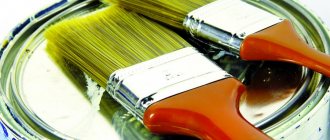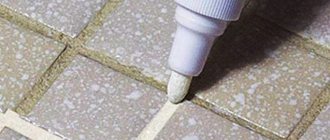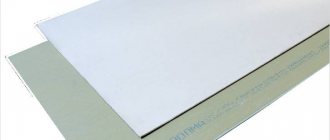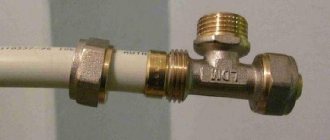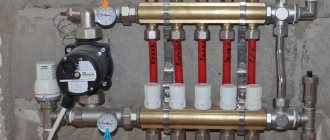During cosmetic repairs, very often old pipes begin to catch the eye and spoil the entire appearance. Even if these plumbing elements are painted with fresh paint, this will not make them attractive and will not make the room more beautiful. Usually in small bathrooms, during a light renovation, the question arises of how to decorate the pipes in the bathroom in such a way that they fit well into the interior and do not attract attention to themselves. In this article we will tell you how to arrange a bathroom with open pipes and provide photo examples.
Painting nuances
Today, modern materials are used in the construction of houses and laying communications: plastic, stainless alloys, non-ferrous metals. And the communications themselves - sewerage and water supply - remain mostly hidden.
Heated towel rails are made of stainless steel or have a galvanic coating. But in old houses there are still pipes made of ferrous metal (cast iron and steel).
They are susceptible to corrosion, do not look aesthetically pleasing and require increased attention, including proper regular painting.
Metal pipes
Before painting, metal pipes need preparation, which consists of washing and removing old paint and rust.
It is recommended to prime metal pipes before painting - the primer will perform protective functions, extend the service life of the pipes and create conditions for good adhesion of the coating to the metal. If the pipes are cold, you need to make sure there is no condensation before applying paint.
If possible, it is better that the pipe is not hot at the time of painting. On a hot surface, paint dries very quickly, and if you are not experienced, it may be difficult to get the perfect result right away.
Galvanized pipes
They do not need to be painted, except for areas where the coating is damaged (threads or welds), such areas must be protected.
Polymer pipes
Plastic pipes do not need protection. Their painting can only be caused by the desire of the owner and interior considerations, since the standard colors of plastic pipes (white or gray, sometimes green or beige) do not always go well with the interior.
It is recommended to treat plastic products with non-aggressive compounds that do not contain acetone. This applies to solvents, primers, and paints. Speaking about the usefulness of a primer for plastic pipes, it should be noted that this is not the most essential element. Properly selected paint fits well on a polymer pipe.
How to level the walls in the bathroom for tiles? Step-by-step instruction.
Read here about the advantages and disadvantages of epoxy grout for bathroom tiles.
Varieties
There are three types of suitable paints for heating pipes:
- alkyd;
- acrylic;
- water-dispersed.
Alkyd paints are ubiquitous and are very popular because they are relatively inexpensive. They have a sharp, unpleasant odor that remains even when the mixture is completely dry. The smell begins to appear when metal or plastic heating pipes are heated. After some time, the painted layer will fade and change its shade, especially if white was chosen. The alkyd composition dries completely in about 24 hours; after about 5 hours after painting, the surface no longer sticks.
Acrylic paints are made with a small addition of organic solvents; there is a smell when working with these dyes, but it is much weaker than that of alkyd compositions. Acrylic paints come in a wide range of colors and dry very quickly, in about 1-2 hours. Most often, before applying them, you have to prime metal heating pipes or a gas pipeline. They produce both matte and glossy acrylic compositions. The gloss shines very beautifully, and the matte layer perfectly hides various defects on the treated metal surface. Over time, the color of the coating does not change.
Water-dispersion compositions are the safest and most environmentally friendly paints. In terms of their attractiveness and durability, they are not inferior to other types of paint and varnish products. They dry quickly enough and have absolutely no odor. When choosing a water-dispersion solution, it is important to pay attention to the label or container with the color mixture; it should say that the paint can be used for heating radiators or heating devices.
Which paint to choose?
For metal pipes, paints and primers based on organic solvents are optimal; water-soluble ones are not suitable.
Today, compositions are offered that combine primer and paint. This makes the job easier. But the traditional method gives more reliable results. The primer provides good adhesion to the metal, the paint adheres well and has a smooth top layer. In addition, such “two-in-one” compositions are presented in a limited range of colors, unlike paints.
The following paints are popular and in demand:
- Alkyd enamel . It is resistant to various influences, including temperature changes. Disadvantage: from the moment of application until complete drying, it emits an unpleasant odor.
- Water-dispersion paint . It has a long service life, dries quickly, has virtually no odor, and is absolutely safe.
- Acrylic enamel . It is durable, aesthetically pleasing, and has good consumer characteristics.
The cost of paint for metal starts from 150 rubles/kg. When painting hot pipes, it is advisable to choose heat-resistant paint.
The following paint options are suitable for painting polymer pipes:
- acrylic and pentaphthalic based on white spirit,
- aqueous compositions for mineral surfaces: dispersed, emulsion, acrylic, organosilicon,
- water-soluble for joinery.
Composition selection
To ensure the best effect from using paint for heating pipes, when choosing a composition in a store, it is better to purchase paint with the inscription “for heating radiators” or a similar mark. Such a coloring mixture will be resistant to high temperatures, and when heated it will not change its color. One of the budget options is PF-115 enamel, which meets almost all the basic requirements given above. Heat-resistant paint KO-168, which has a silicon base, is also very good.
It is better not to use oil paint for pipes heated to high temperatures, since the oil composition will certainly fade or turn yellow after some time. In addition, oil dyes have an unpleasant, persistent odor during painting and drying.
Attention! If you choose paint for metal pipes, it must contain a corrosion inhibitor that will protect the metal surface from moisture in the air. If the composition does not contain such an additive, then before painting, the heating pipes must be coated with a layer of anti-corrosion primer. One suitable primer is lead-lead primer mixture No. 81.
Step-by-step instruction
Almost anyone can paint the pipes in the bathroom; it does not require enormous physical effort.
It is necessary to choose the right paint and primer.
If the pipe is metal, then you will need the following set of tools and materials:
- Tools that can be used to clean pipes from old paint and rust (grinder with cleaning disc, metal brush, sharp spatula, sandpaper).
- Rust conversion products.
- Flute brush, roller.
- Cuvette.
- Primer.
- Dye.
- Rags for wiping, materials for protecting floors and walls from accidental paint.
- Gloves.
The procedure is as follows:
- We close the walls and floor around the pipe.
- We clean the pipe from the old coating.
- We treat areas with traces of rust: remove rust with a stiff brush, sand with sandpaper, and treat with a rust converter.
- Carefully wipe the pipe with a damp cloth to remove dust, then wipe it dry.
- Apply primer.
- After the primer has dried, you can paint it. It is better to use a roller, using a brush in hard-to-reach places.
- After the first layer has dried, you can apply the second.
How to remove old grout from tile joints
with your own hands?
Find out in this article how to cover the pipes in the bathroom with plasterboard with your own hands.
Preparing the base
Preparation includes not only cleaning the pipes, but also protecting floors, nearby objects and walls so that paint does not get on them. For protection, you can use cellophane film, oilcloth, unnecessary magazines, newspapers, pieces of cardboard, etc. Even if you paint very carefully and slowly, the composition will still drip or splash on the floor and walls. It’s best to play it safe in advance, so you won’t have to remove the paint mixture from objects.
Important! You should prepare personal protective equipment in advance, such as thick work clothes, rubber gloves, a respirator, goggles and a hat.
Before you start painting heating pipes or gas pipes, you must remove any contaminants, such as dust, debris, dirt, grease stains, etc. In addition, it is advisable to remove old paint and varnish material, especially those that do not adhere well, are peeling and cracking. But if the paint layer holds firmly and there are no defects on it, then you can lightly sand it with regular sandpaper.
To remove grease stains, use either a slightly alkaline liquid or a solvent, such as white spirit. If there is rust on the metal surface of the heating pipes, it must be removed as thoroughly as possible. Sandpaper is often used for this. In addition, rust can be coated with a special compound that converts the rust layer into a hard and durable layer.
Painting pipes inside and out or how to paint pipes correctly?
| Wednesday, 16 April 2014 16:45 |
Modern houses have built-in various engineering networks, including sewerage pipes, hot and cold water supply, gas pipelines and other highways. To protect against corrosion and give an aesthetic appearance, their additional processing is often relevant. In this situation, it is easiest to use paint with suitable properties if the pipe is relatively accessible.
Many will say that almost everywhere the water supply is already installed using polypropylene and metal-plastic pipes, but there are still many places where iron pipes are installed. We also must not forget that many of their summer cottages still have irrigation water pipes made of iron pipes, which also need to be renewed by painting every spring. And so, let's talk about everything in order! And we will naturally begin with the stage of preparing pipes for painting.
Preparing to paint iron pipes
How to paint water pipes depends on the material from which they are made, as well as on the temperature conditions. In the process, you may need not only paint and a brush, but also sandpaper, a cuvette, primer, rags, gloves, etc. First, you will have to clean off the remnants of the previous paint (if any), then prepare the surface by sanding off rust and degreasing.
Then remove dust from the floor and ventilate the room so that no impurities interfere with painting. Before you start painting, it is wise to place the dishes so that drops of paint do not stain the floor.
Where to start coloring?
Painting an easily accessible pipe is easiest; a riser or battery is much more troublesome. You should start from top to bottom and leave no gaps. When dry, apply a second layer.
Often the pipes turn out to be plastic (for example, polypropylene). These are washed with warm water and dried before painting. It is better to use water-based or oil-based paint to match the color of the walls.
How to paint black pipes?
Cast iron and steel pipes in communications are a common occurrence. This is the so-called ferrous metals (as opposed to non-ferrous ones, of which brass or pure copper is most often used in the manufacture of pipes), products made from such materials are also called similarly. Their greatest vulnerability to corrosion is predictable. Before painting black pipes, they will have to be especially carefully prepared: cleaned of both rust and dust.
The metal must be dry before painting. For steel and cast iron objects, a special enamel is relevant - a mixture of a rust converter, a primer with anti-corrosion properties and enamel itself with high wear resistance.
The more carefully the entire surface is painted, the longer such a pipe will last. It should also be coated in 2 layers.
How to paint a sewer pipe?
This need arises only for metal highways. Modern sewer networks are made with extensive use of plastics, which do not require paint. If this is dictated by the desire to give the protruding pipe a more aesthetic appearance, yes, painting it is easier than redoing it.
How to improve a heated towel rail?
Making an art object is simple:
- buy paper for covering windows with a sticky layer applied;
- cut the bay in half with a sharp knife to get narrower strips:
- wrap the entire heated towel rail with this paper, laying it in even turns;
- the resulting surface is coated with any decorative paint.
30 Dec
2022 Interesting materials:
How to find root in Python? How to find a short circuit in a car with a multimeter? How to find any music in a telegram? How to find net and gross mass? How to find the mass of a substance Chemistry 8th grade? How to find the mass of water in chemistry? How to find a short circuit in the wiring? How to find fashion in Excel? How to find the constellation Gemini in the sky? How to find the direction of a cross product?
What paints are suitable for painting plastic sewer pipes?
Over the past few years, plastic has become the main material from which sewer and water pipes are made. For these purposes, polyethylene, polystyrene or polyvinyl chloride are used. Plastic communications are light, smooth and resistant to rust, but their color does not always match the decoration of the walls in the bathroom, and the pipes look unaesthetic. A home craftsman who decides to take on renovations often faces the problem of choosing paint.
Plastic pipes can be painted with the following types of coatings:
- nitrourethane (for example, one-component paint for automotive plastic ESKA-5104);
- acrylic (primer enamel for plastic “KUDO” or aerosol paint “Bosny”).
It is not recommended to use oil paints or latex compounds. They don’t fit well on plastic and quickly peel off in large patches. Acetone-based coatings are also unacceptable, since they interact with plastic, dissolving it.
- sand the smooth pipe to a slight roughness;
- wash and dry the surface;
- degrease using a special degreaser or white spirit;
- apply primer for plastic and dry;
- Spray paint onto the surface of the pipe in thin layers in several stages, observing the time intervals specified in the instructions.
Which plastic pipes can be painted?
Although plastic is a durable, reliable material with excellent heat dissipation, it is very difficult to paint. For example, when installing polyethylene and polypropylene pipes, you must immediately abandon the idea of changing the color. These materials cannot be painted due to their technical properties; even the most tenacious paint will not be able to cover them evenly. Polypropylene pipes can be painted only with preliminary preparation of the material. ABS and PVC plastic can be modified using water-based acrylic paint. But its application also requires preliminary priming and cleaning. Without preparation, the coating will be uneven, with smudges and bald spots. Conditions during dyeing also play an important role. The room temperature should not be lower than 18 degrees, otherwise the paint will crack. Humidity no higher than 80% will have a positive effect on the adhesion of plastic and pigment.
Types of pipes.
How to hide a sewer pipe?
The riser in the bathroom can be hidden in several ways. One of the most affordable options is sewing pipes into a plastic box. Experienced craftsmen recommend this type of camouflage for apartments with old communications. They argue that if one of the worn-out pipes leaks, the plastic structure will be easier to dismantle and install back after the repair.
For finishing a bathroom in a new building, the second option is more acceptable: a plasterboard box lined with tiles. This method requires more effort and money, but it is more aesthetically pleasing. The box can be equipped with a secret hatch for access to the pipes. As a rule, new risers do not require major repairs, and the likelihood that you will have to break the drywall along with the tiles glued to it is minimal.
How to decorate a pipe in a toilet or bathroom without painting?
Alternative methods of decoration are used in cases where paint does not adhere to pipes (for example, polyethylene or polyurethane), and the lack of space does not allow them to be sewn into a plastic or plasterboard box. Or the apartment is rented and cannot be renovated.
One way out is to cover the pipes with self-adhesive film of a suitable color. This is an inexpensive and easy to implement option. Communications can be decorated by entwining them with artificial vines made of washable material. In this case, the pipes turn into an original decoration.
Color selection
Manufacturers of paints for heating pipes usually offer several different shades of paints and varnishes. You need to choose one color or another based on your aesthetic taste, the interior features of the room and the available lighting. In addition to standard colors, some prefer to use metallic dyes that imitate bronze, chrome, silver, and gold. In addition, you can combine several shades with each other, you can apply patterns to heating appliances or heating pipes.
If you focus on heat transfer, then it is best to use a dark paint color, because it enhances the heat transfer from heated pipes.
Useful tips
You should work in gloves and work clothes, and when spraying aerosol materials, wear a mask and goggles. All tools must be promptly cleaned of paint before it dries. The floor under the pipe and other nearby surfaces must be covered with film in advance, then they will not have to be cleaned from accidentally falling drops of paint.
Many compounds have a strong odor or contain toxic volatile components, so you need to ensure a constant flow of fresh air into the work area. This can be done by opening the door and placing a fan on inside the washroom.
I hope you have received the necessary recommendations to decorate your sewer pipes. The following video offers another way to design communications.
This entry was posted on Saturday, March 7th, 2022 at 12:05 am and is filed under Category name. You can follow any responses to this entry through the RSS 2.0 feed. You can leave a response, or trackback from your own site.




